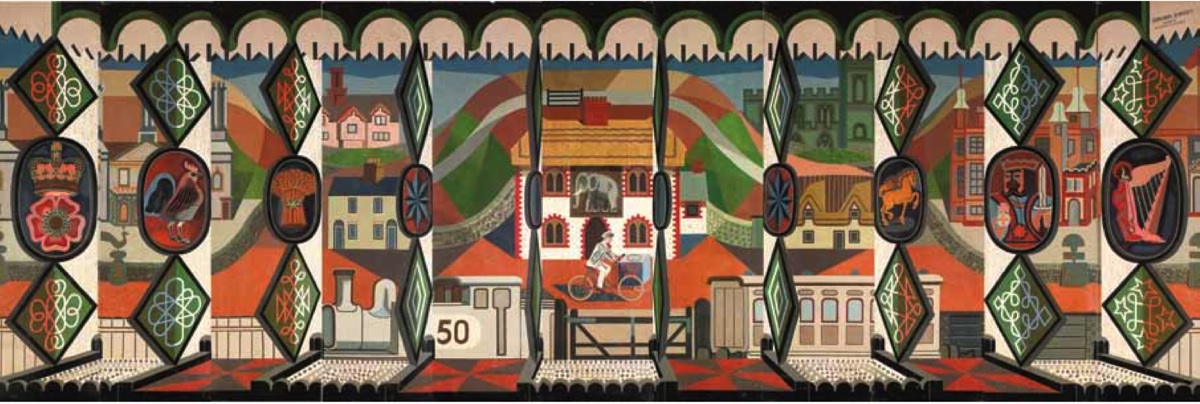I could quite happily just give you this single picture and consider it a complete post, because it’s just fantastic
What I’m showing you here is a three and half metre long mural by Barbara Jones called ‘Out in the Hall’ from 1962. I have no idea what it was painted for – although given that it was still in her studio in 2010 she may just have produced it for her own pleasure – but it was displayed in a Victoria & Albert Museum exhibition called Mural Art Today in 1962.
The truly extraordinary thing about it, though is that it is for sale through Liss Fine Art. There’s a button on the page which just says ‘Add to Cart’. I’m so tempted. The only drawback is that it costs £12,000, which means we’d have to choose between a bear on a yellow background and a functioning kitchen. I took this vote to Twitter, where the vote was overwhelmingly in favour of the bear. I’m not entirely convinced yet though.
To be honest, that one mural would be quite enough for me, but there is much, much more where that came from too. Because Liss have organised an exhibition called British Murals & Decorative Painting 1910 – 1970, and what’s on display, and in many cases on offer, is really quite extraordinary.
Highlight – simply for the fact that it still exists in any shape or form at all – is the John Piper mural called ‘The Englishman’s Home’, which he designed for the exterior of the Homes and Gardens Pavilion at the Festival of Britain.
Here it is in situ, with a bin.
Amazingly, this too is for sale, although for ‘Price on Request’, which I always translate as, ‘if you have to ask, you can’t afford it’. I imagine they’d also want to vet you too, if only to make sure that you actually had the space to keep over sixteen metres of John Piper under proper conditions. But that really ought to be in a museum, don’t you think? Is there a campaign to get it for the V&A do you know? And if not, shall we start one?
While we all consider that, there are other gems to eye up too. This Edward Bawden was produced for the SS Oronsay in 1951, but is now in a private collection.
Or this Claude Francis Barry, produced for nobody knows quite what or why during the war but unbelievably evocative.
I could go on almost indefinitely until I reproduced the entire collection, but I won’t, for a few reasons.
The first is that there is, I think a lot more to say about these works and right now I don’t know enough to say it. A book has come out to accompany the exhibition and I think I’m going to need to absorb that first before I come to any definite conclusions.
But there is definitely something interesting going on here that hasn’t really been described properly before, and to me it looks like a graphic and representational style which is half way between fine art and posters. This Mary Adshead could nearly come from a Shell poster of some kind.
It was intended to be one of eleven designs, but I’ll let the catalogue tell you the history of the piece, because it’s rather wonderful:
The Puncture and The Village Inn were two of eleven scenes in the series An English Holiday, commissioned by the British-Canadian business tycoon and politician Lord Beaverbrook, early in 1928, for the dining room at Calvin Lodge, Newmarket. The commission for An English Holiday was withdrawn by Lord Beaverbrook in August 1928, apparently after the intervention of his friend Lady Diana Cooper who felt that Beaverbrook would quarrel with most of the people (his friends and acquaintances) who served as the models for the scheme.
These murals also, perhaps, let us into another way of discovering a very British strand of art, one which stands so far outside the mainstream of continental modernism that it hasn’t properly been described yet.
There’s a good reason, too, for why very little of this has been described. A note in the catalogue estimates that at least 90% of the murals of the period have been destroyed. Barbara Jones, for example, produced at least 29, of which only two are known to be still extant. The other one is in the exhibition too – produced for the International Labour Exhibition in Turin in 1961.
Price on request. Sigh.
Finally, I don’t have time to think about this now because the exhibition isn’t on that long – only until 9th March, so you do really need to go and see it while you can. As do I.







I shall look forward to your later comments on the exhibition, as I have just been leafing through the catalogue. I am sure there are links with popular graphic arts, children’s book illustrations, and the Merivale School Prints, and Lyons Teashop prints,etc. I have no recollection of the art and design at the Festival of Britain on a school visit – but it must somehow have seeped in as I am very drawn to the artists of this period.
And do you think bears (in kitchens) will become the latest thing in fashionable interiors?
Liss did exhibit the John Piper at the South Bank in the Queen Elizabeth Hall during the last summer celebrations of the Festival of Britain. It looked fantastic in that rightful setting,
and it was for sale then, but for some reason they didn’t purchase it then.
A bear should be in every kitchen, at least in my world.
I think the Piper should be in the V&A myself, what with them having both paintings and design. And having the space to exhibit it.
SS Oronsay, for which the Bawden was created, starred (according to Wikipedia) in Carry on Cruising… which happily was filmed in colour…
Now there’s a research project for a Sunday afternoon…